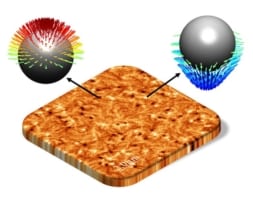
A new light-driven levitation technique could soon enable tiny, low-cost aircraft to achieve the first sustained flight in the Earth’s mesosphere. Mohsen Azadi and colleagues at the University of Pennsylvania University exploited the effect of photophoresis, combined with an intricately shaped light beam, to levitate thin mylar disks at low pressure in a vacuum chamber. Their microflyers could soon allow researchers to explore one of the most poorly understood parts of Earth’s atmosphere in unprecedented detail.
Situated between 50-80 km above Earth’s surface, the mesosphere is a no-man’s-land for sustained flight. At these altitudes, air density is too low to generate lift for airplanes, but still high enough that space-based satellites will experience unsustainable drag and burn. One emerging solution lies in the use of light-driven motion, known as photophoresis, as an alternative propulsion mechanism. The effect has been widely observed in small particles such as atmospheric aerosols. When illuminated by suitably intense light beams, they will move due to non-uniform temperature distributions that form in the air surrounding them.
Azadi and colleagues aim is to use photophoresis to levitate much larger objects, starting with a design based on a circular mylar film that is 6 mm in diameter and 500 nm in thick. On the underside of the disk, they deposited a 300 nm-thick layer of tangled carbon nanotubes, creating a network of microscopic air traps. They then placed their structure inside a vacuum chamber, and reduced the air pressure to as low as 10 Pa – just a small fraction of the atmospheric pressure experienced on Earth’s surface (about 100 kPa).
Net upward force
To levitate the disks, the researchers illuminate them with a light intensity comparable to sunlight, causing them to heat the sparse surrounding air. On their undersides, air molecules trapped by the carbon nanotubes are heated for longer than those on the upper sides of the disks. As a result, these molecules reached higher velocities when they finally escaped from the traps, generating a net upward force.

Sonic tractor beam grabs hold of large objects
To control the flight paths of their aircraft, Azadi and colleagues designed an optical trap using a specially shaped light field. At the centre of the beam, light intensity was just high enough to levitate the disks. Yet surrounding this region, a ring of higher light intensity pushed the disks back towards the centre when their paths deviated. Finally, researchers constructed a theoretical model from their results, allowing them to predict that the lifting force generated by a microflyer could be many times larger than its weight.
With much more development, the concept could enable low-cost aircraft to achieve sustained flight at altitudes ranging from 50-100 km, and even carry payloads as large as 10 mg. Their cargo-carrying abilities may increase even further if hundreds of microflyers were joined together by lightweight carbon fibres – enabling them to carry equipment such as smart dust sensors, and devices to track atmospheric circulation patterns. Ultimately, this would open broad new areas of research into one of the least understood parts of Earth’s atmosphere.
The research is described in Science Advances.



